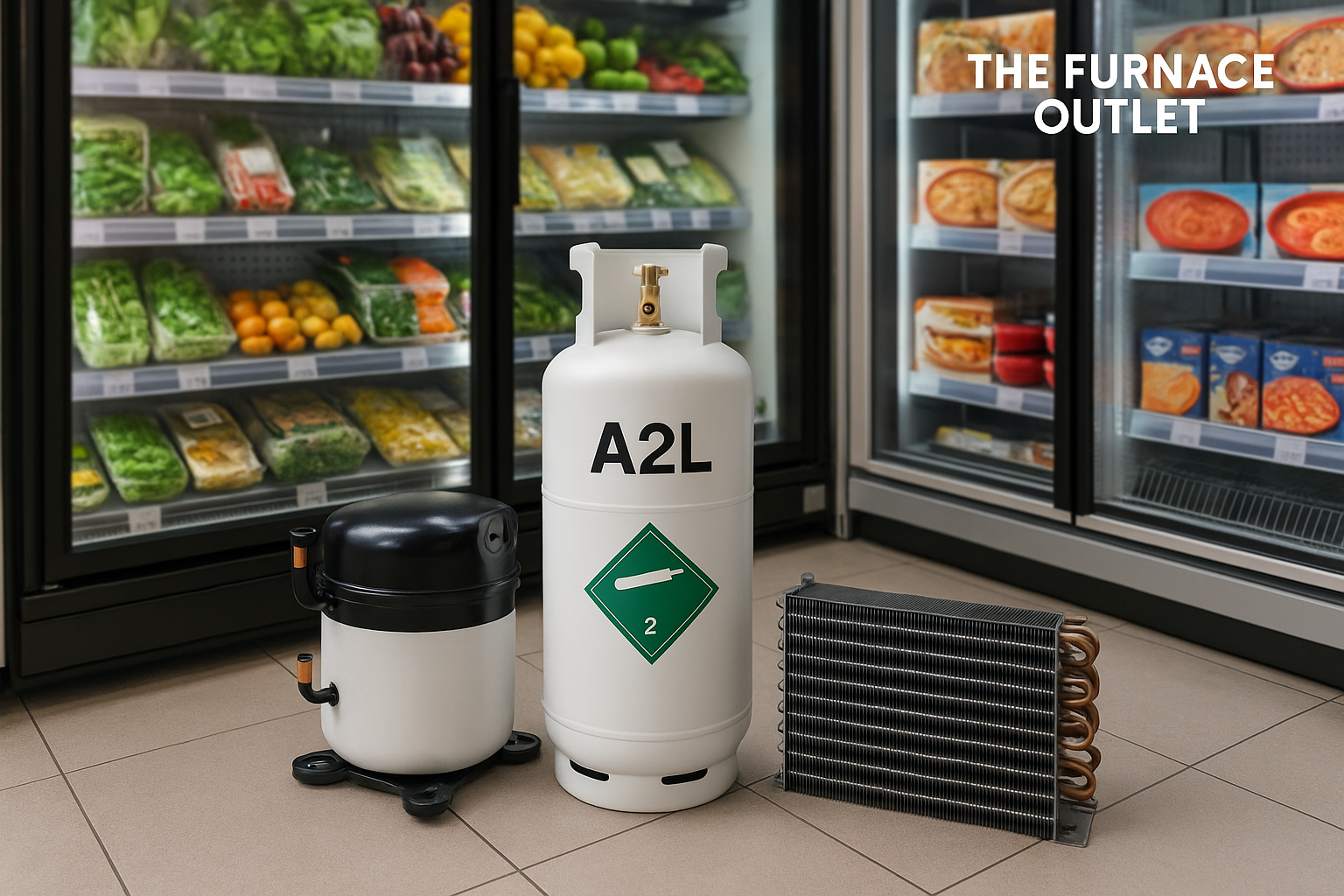As grocery retailers face mounting pressure to cut emissions and boost energy efficiency, A2L refrigerants are emerging as a forward-thinking solution. These mildly flammable, low-GWP refrigerants are changing how supermarkets cool everything from fresh produce to frozen goods—delivering energy savings, regulatory compliance, and improved environmental performance.
But adopting A2Ls means more than swapping out gases—it’s a shift in how refrigeration is engineered, monitored, and maintained. This article breaks down what makes A2L refrigerants different, how supermarkets are adapting, and what lies ahead for safer, greener cooling.
Explore R32 air conditioners and gas furnace systems designed for modern efficiency and environmental performance.
Why Refrigerants Matter More Than You Think
Behind every cold aisle in a supermarket is a complex refrigeration system that quietly keeps perishables safe. At the heart of that system is the refrigerant—a substance that absorbs and releases heat to regulate temperature. Traditional refrigerants like R-404A and R-134a have done the job well but come with major drawbacks: high global warming potential and tightening regulations.
If you're comparing your options, this breakdown of R-454B vs. R-32 shows how both A2Ls support energy efficiency while meeting regulatory mandates.
A2L refrigerants strike a new balance. They offer lower GWP, improved thermodynamic performance, and growing compatibility with modern refrigeration equipment. For supermarkets, that translates to lower emissions and smaller energy bills without sacrificing cooling reliability.
Find A2L-safe accessories like leak detectors and sensors to upgrade safety in commercial refrigeration systems.
Built-In Safety: How Supermarkets Mitigate A2L Flammability
A2Ls are classified as "mildly flammable," which understandably raises concerns. But the risks are manageable—and the industry is responding with smart safeguards.
-
Leak detection sensors are now standard, instantly alerting staff to leaks before they become dangerous.
-
Ventilation upgrades help disperse any leaked refrigerant quickly, lowering the chance of ignition.
-
System designs are increasingly tailored to contain and manage A2Ls safely, with features like sealed compartments and enhanced pressure controls.
Perhaps most important: training. Supermarket technicians are learning how to safely install, maintain, and troubleshoot A2L systems. This guide to A2L training and compliance highlights what professionals need to know to operate safely and stay compliant.
Efficiency That Pays for Itself
Energy efficiency is no longer a nice-to-have—it’s a bottom-line necessity. And that’s where A2Ls really shine.
Compared to legacy refrigerants, A2Ls can deliver:
-
Up to 20% energy savings in well-designed systems
-
Lower operating pressures and reduced compressor strain
-
Enhanced heat exchange efficiency
For large retail chains running dozens—or hundreds—of cooling units, that translates to major utility savings. And with most A2Ls requiring smaller refrigerant charges, supermarkets also reduce their total environmental footprint.
Browse energy-efficient R32 packaged heat pumps that support high-volume commercial applications.
How A2Ls Stack Up Against HFCs
Why are so many retailers moving away from HFCs like R-404A and R-507? The numbers tell the story:
|
Refrigerant |
GWP (Global Warming Potential) |
Flammability Class |
|
R-404A |
3,922 |
A1 (non-flammable) |
|
R-134a |
1,430 |
A1 |
|
R-454B |
466 |
A2L |
|
R-32 |
675 |
A2L |
A2Ls offer dramatically lower GWP, helping retailers stay ahead of HFC phasedown mandates. While A1s are non-flammable, their environmental cost is far higher—a trade-off regulators are no longer willing to accept.
Keeping Up with the Rules: Regulatory Drivers Behind A2L Adoption
The global shift to A2Ls is being accelerated by climate-focused legislation:
-
The Kigali Amendment mandates a global phasedown of HFCs.
-
U.S. AIM Act enforces a 40% reduction in HFCs by 2024, and 85% by 2036.
-
EU F-Gas Regulation is pushing retailers to adopt lower-GWP alternatives like R-454B and R-1234yf.
Retailers need to stay proactive. This A2L refrigerant roadmap explains how to stay ahead of regulations while building smarter, greener refrigeration systems.
Start with a R32-compatible packaged air conditioner built to meet today's compliance benchmarks.
Overcoming the Roadblocks: Cost, Complexity, and Conversion
Transitioning to A2Ls isn’t a plug-and-play process. Key challenges include:
-
Retrofitting systems to meet A2L safety and performance standards
-
Upfront capital costs for new compressors, controls, and detection systems
-
Training staff on flammable refrigerant handling and emergency procedures
However, these hurdles are temporary. Over time, energy savings, fewer emissions, and better equipment longevity deliver strong payback. Retailers that plan ahead—partnering with certified contractors and investing in workforce training—can transition smoothly.
Consider PTAC A2L systems for compact store spaces and quick installs.
Real-World Success: Supermarkets Leading the A2L Charge
Several retail giants are already showing what’s possible:
-
A European grocery chain cut energy use by over 15% after retrofitting 500 stores with A2L systems using R-454C.
-
A U.S. supermarket brand replaced aging HFC systems with R-1234yf units, supported by utility rebates and internal carbon targets.
-
A Japanese retailer met tough national emissions rules by adopting compact, low-charge A2L refrigeration cases—with zero safety incidents reported after two years.
These case studies prove that with the right planning, A2Ls deliver on their promise.
What’s Next: Smarter, Greener, and More Connected Cooling
Looking forward, the next wave of refrigeration innovation includes:
-
IoT-enabled systems for real-time leak alerts, performance tracking, and predictive maintenance
-
Natural refrigerants (like CO₂ and ammonia) integrated into hybrid systems with A2Ls
-
Modular cooling cases using factory-sealed A2L systems that simplify installation and limit leak risk
With sensor-driven automation, retailers can unlock better reliability and real-time control. Learn how smart leak detection tech is transforming risk management and compliance for A2L systems.
A2Ls Are the Bridge to a Cooler, Cleaner Future
Supermarkets don’t just keep food cold—they now play a critical role in reducing climate impact. A2L refrigerants offer a practical, safe, and forward-looking way to modernize cooling systems while staying ahead of regulation.
Yes, the path comes with challenges—but also undeniable long-term rewards. For supermarkets committed to sustainability and operational excellence, A2Ls are more than a refrigerant upgrade—they're a strategic advantage.
Ready to modernize your refrigeration systems?
Shop A2L-compatible cooling solutions at The Furnace Outlet and take the next step toward safer, more sustainable supermarket operations.







